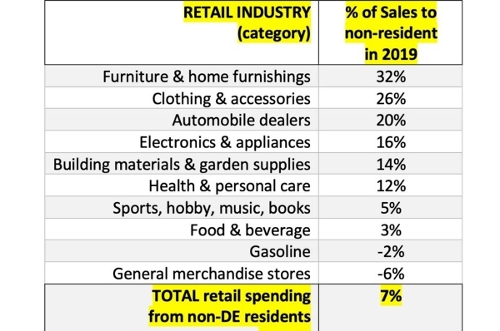
Center for Economic Policy and Analysis
October 31, 2020
Delaware state government is facing two years of flat general tax revenue. If instituting a state sales tax becomes a legislative issue, retailers may suffer substantial non-resident sales losses.
Pros vs. Cons of a sales tax?
The biggest "pro" for a sales tax means that Delaware government revenues will grow at pace with inflation and the economy.
The biggest "con" is that lower-income families tend to spend almost all their money on consumption, while higher-income families save their money, thus making a sales tax a regressive tax.
The other obvious "pro" is being contiguous to several other states (NJ, MD, PA). No sales tax induces non-residents to spend their retail dollars in Delaware.
No sales tax boosts Delaware’s retail industry.
Still, the benefits vary significantly by category-see Table 1 below.
According to the U.S. Bureau of Economic Analysis, in 2019, Delaware's retail industry's GDP totaled $2.89 billion.
The U.S. Business Labor and Statistics Quarterly Census of Employment and Wages reports that non-resident spending is estimated to have accounted for 7% of Delaware’s total retail sales in 2019 ($202.3 million).
However, as shown in Table 1, the contribution of non-resident spending varies widely by category.
- Retailers benefiting the most from non-resident sales include large ticket purchases: furniture and automobiles.
- Clothing, being such an essential part of total household spending, also benefits from Delaware’s lack of a sales tax.
- Next in importance are electronics and appliance stores, building materials and garden supplies, and drug stores. (But the same impact of large ticket items is found within these retail categories. For example, only 4% of computer and software sales come from non-residents compared to 43% of household appliance sales.)
- Delaware’s lower gasoline tax compared to surrounding states (NJ, MD, PA) does not seem to be an inducement to non-resident sales.
- Among the general merchandise stores, sales at warehouse clubs and supercenters are boosted by 4% by non-residents.
- Still, department stores have sales substantially below than expected.
|
|
|
